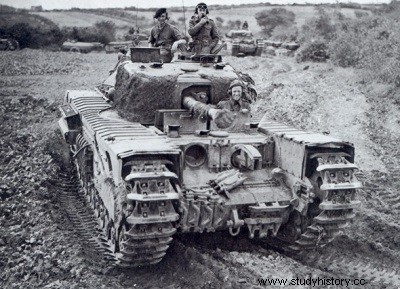
Leaving the latter in the care of the anti-tank guns, he charged the Panzergrenadieren with bayonets to force them to drop out. But the pressure from the enemy was too strong. By nightfall, the Thomas company was reduced to its chief, a sergeant and five men. The brigade gave the order to withdraw and Lee was finally allowed to join East Surrey with the survivors of his battalion, in flank-guard on their left for the night.
In fact, their fight had taken place just behind that of the Hampshires and Lee was about to fall from Charybdis into Scylla. The front was narrower, however, between the Medjerda on the right and the hills on the left, with Hill 186 forming the key to the position held by the Surreys. The following day the Germans launched their heaviest assault against the two battalions.
The Surreys were forced back into the midst of their own artillery, and lost 7 of the 8 25-pounder guns of the 322nd Battery.
But the Surreys had lost Hill 186, leaving the Hampshires' left flank exposed. The ridge was soon crowned with Spandau machine gun emplacement which opened a plunging fire with deadly effect. The English counter-attacks were now carried out only by handfuls of men. In a final attempt, Major H.W. Le Patourel made it to the ridge with four men, firing and throwing grenades at the machine guns. His four men fell one after another. He was then seen to mount the charge alone, pistol in hand, and disappear. Everyone thought he was dead and the Victoria Cross was awarded to him posthumously.
Yet he survived and was later found, wounded and prisoner in a hospital in Naples.
When night came, the indomitable Colonel Lee formed a square around his P.C., with the intention of retaking Hill 186 under cover of the darkness, and holding it as long as possible. But the inventory of its resources revealed that it had only 200 men left, many of them wounded, and that ammunition and water reserves were practically exhausted.
The enemy, in fact, overwhelmed the exhausted survivors. Determined never to surrender, Lee ordered anyone who could walk to take a gun and line up. Machine guns at the hip or bayonets fixed, the men charged towards freedom and the survivors reached the road to Tebourba, which they assumed was still under Allied control. In a last gesture of panache, their colonel at the head, the men formed in column by three to march in quick step in the main street of the village. But it was too late, the road was cut off. The remnants of the 11th Brigade had just stalled, and the Hampshires had to head for the mountain. On December 6, four officers and 120 men joined Medjez-el-Bab, they were the only survivors.
Thus ended the unfortunate attempt to break through to Tunis. In strictly military terms, all the credit for the campaign went to Major General Karl Fischer. He had been ordered to slam the doors of Tunisia in the face of the Allies, and he had done it. Brilliantly leading his battle groups, he had taken 1,100 prisoners, and captured 41 artillery pieces and 72 tanks. For the year 1942 the race was lost for the Anglo-Americans. But they still firmly held the starting line for the next race.
